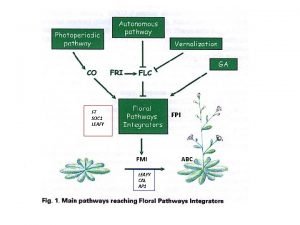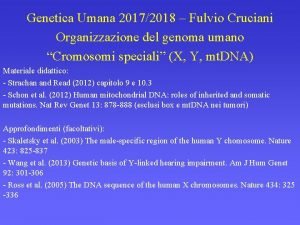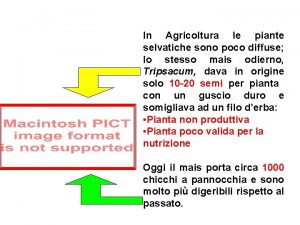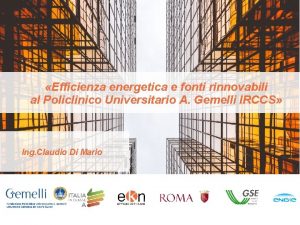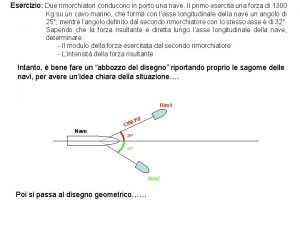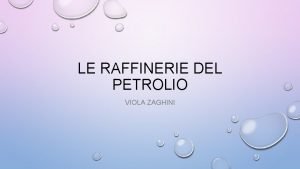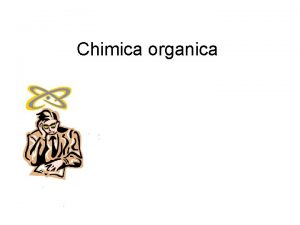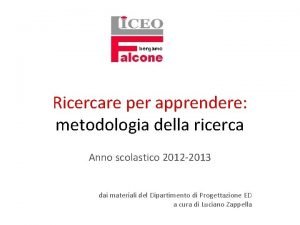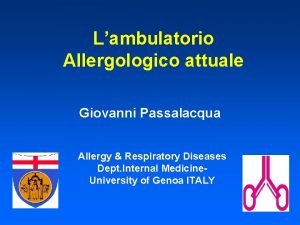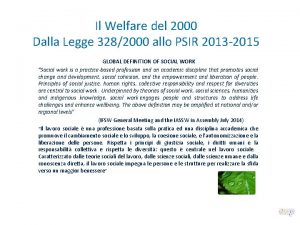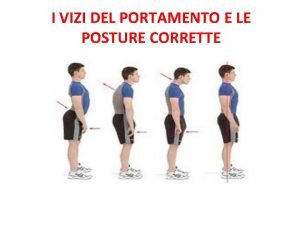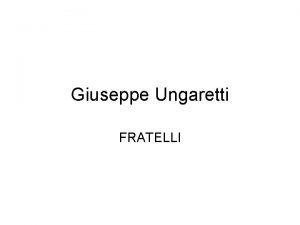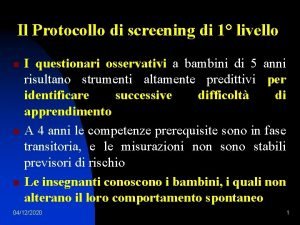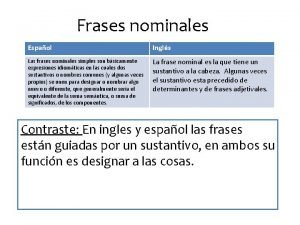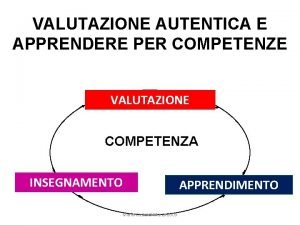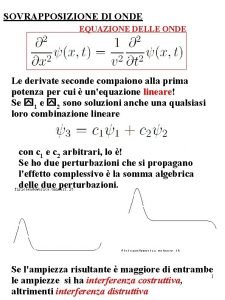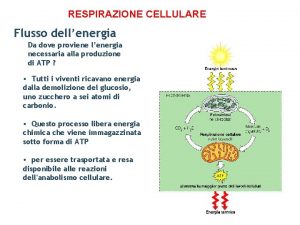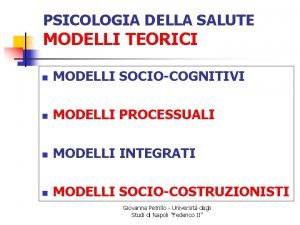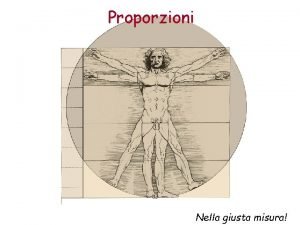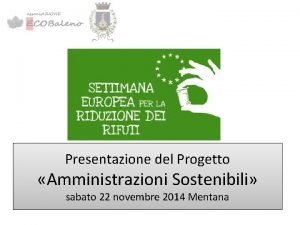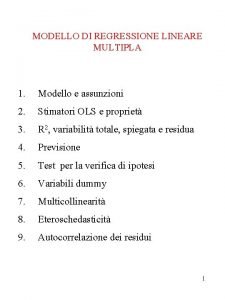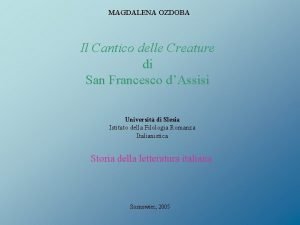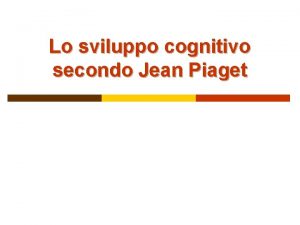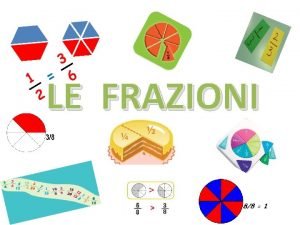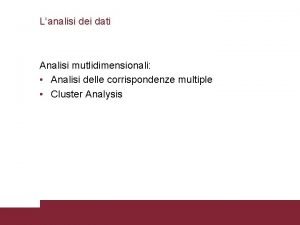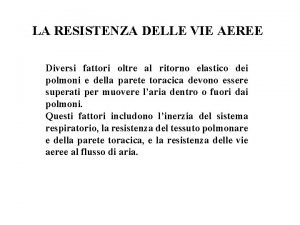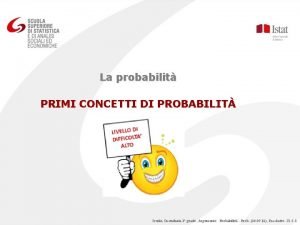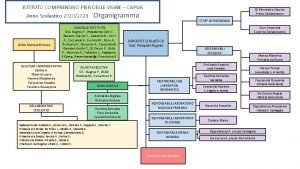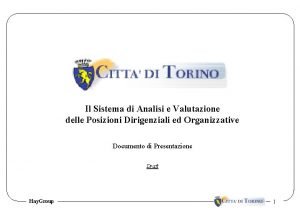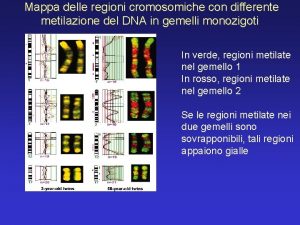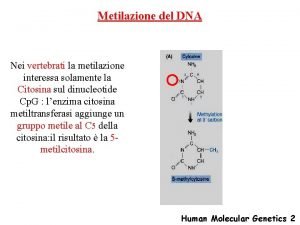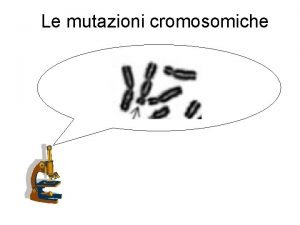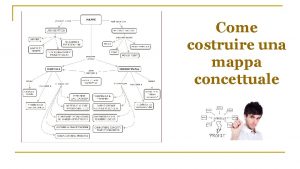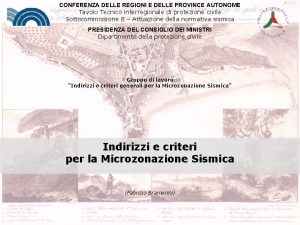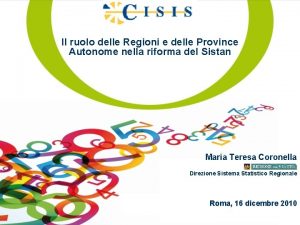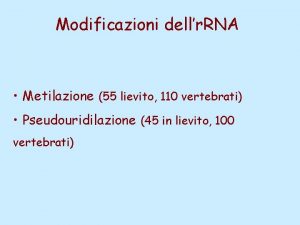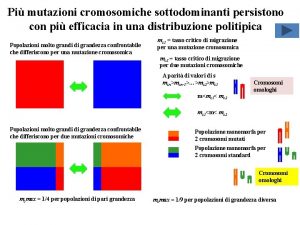Mappa delle regioni cromosomiche con differente metilazione del














































































































- Slides: 110

Mappa delle regioni cromosomiche con differente metilazione del DNA in gemelli monozigoti In verde, regioni metilate nel gemello 1 In rosso, regioni metilate nel gemello 2 Se le regioni metilate nei due gemelli sono sovrapponibili, tali regioni appaiono gialle

Non è solo il genotipo a determinare un fenotipo più o meno vulnerabile verso i fattori di rischio ambientali ma anche l’ambiente stesso … Epigenetics represents a third general type of mechanism that likely contributes to each individual's unique vulnerability or resistance to a psychiatric disturbance. […] Epigenetic changes offer a mechanism by which environmental experiences can modify gene function in the absence of DNA sequence changes …. . Nestler, E

L’ambiente, soprattutto l’ambiente durante lo sviluppo, può “creare” un fenotipo a rischio, un fenotipo vulnerabile.

Ricerche recenti hanno contribuito a formulare l’ipotesi che “epigenetic mechanisms, which exert lasting control over gene expression without altering the genetic code, could mediate stable changes in brain function. ” Storicamente, l’epigenetica nasce per studiare come tratti cellulari possano essere ereditati in assenza di cambiamenti nella sequenza del DNA. Lo studio dei meccanismi epigenetici alla base della trasmissibilità ereditaria sono quindi nati in campi quali la biologia dello sviluppo (differenziamento), ovvero laddove la continuità di specifici pattern di espressione genica fra cellula madre e cellule figlie è cruciale.

“These studies have converged on a set of common enzymatic modifications to chromatin structure that can up- or downregulate gene expression in a manner that is transmissible to daughter cells. These mechanisms also regulate gene expression in neurons, but, as most neurons do not divide, chromatin modifications are instead sustained within individual cells. ”

Attualmente i meccanismi epigenetici sono ritenuti cruciali nelle modifiche plastiche associate con cambiamenti a lungo termine nel comportamento ed in particolare condizioni di resilienza o vulnerabilità. Prima di tutto, cosa sono i meccanismi epigenetici?

Meccanismi epigenetici e plasticità del sistema nervoso centrale

Lo schema di questa parte di lezione 1. Cosa sono i meccanismi epigenetici? 2. I meccanismi epigenetici sono regolati dinamicamente nel tessuto neurale 3. Le modifiche epigenetiche come mediatori dei fenomeni di plasticità 4. Le modifiche epigenetiche come traccia latente 5. Transgenerazionale?

La metafora di Waddington: partendo da un punto comune (lo stesso DNA) le cellule possono raggiungere diversi destini. Così pure i neuroni, i circuiti neuronali e le funzioni da essi mediate.

Cosa sono i meccanismi epigenetici? • Varie definizioni; un definizione attuale li classifica come i meccanismi capaci di alterare l’espressione genica senza variare la sequenza del DNA • Questi meccanismi utilizzano una varietà di effettori e di regolazioni molecolari a livello del DNA che portano ad un riarrangiamento della cromatina.

La metilazione del DNA: meccanismi ed effetti


Portions of chromatin are highly repressed, owing to DNA and histone methylation and the binding of repressor proteins, and might never be accessible for transcription. Other portions of chromatin are in repressed or permissive states; their basal activity is low owing to histone methylation and perhaps other modifications, but the genes are available for derepression and activation in response to transcription factors and transcriptional co-activators. Chromatin remodelling modulates gene expression with high temporal and spatial resolution by permitting small groups of nucleosomes to become more or less open, which consequently enhances or inhibits access of the transcriptional machinery to specific promoter regions.


Synaptic activity Drugs of abuse 2° messenger systems Pathological activity

L’epigenetica in pratica: le modifiche postraduzionali degli istoni agiscono in modo combinatoriale

L’epigenoma: il risultato di un gioco tra “writers” (es. HATs, HMTs) e “erasers” (es. HDACs, HDMs) interpretato dai “readers”. HDACs= enzimi che rimuovono l’acetilazione dagli istoni HATs= ennzimi che inducono l’acetilazione degli istoni

Perché chi studia il sistema nervoso si interessa dell’epigenetica? a. I meccanismi epigenetici sono regolati dinamicamente nel tessuto neurale


La regolazione attività-dipendente della trascrizione genica è importante per la plasticità neurale. La regolazione mediata dai meccanismi epigenetici potrebbe reclutare geni coinvolti nelle modifiche neuronali alla base della plasticità. 3 esempi: Apprendimento Plasticità dei periodi critici dello sviluppo Plasticità maladattativa (dipendenza da droghe)

L’acetilazione degli istoni regola la formazione di diversi tipi di memorie in diverse specie Prove sperimentali: L’induzione di plasticità sinaptica (LTP) è associata all’attivazione dell’acetilazione degli istoni. La formazione della traccia di memoria è associata con l’induzione di acetilazione degli istoni Il blocco farmacologico degli erasers dell’acetilazione degli istoni (HDAC inhibitors: e. g. tricostatina, sodio butirrato, vorinostat) favorisce la formazione di memoria a lungo termine Mutazioni di writers dell’acetilazione istonica (CBP) determinano deficits di LTP e memoria

Il periodo critico per la deprivazione monoculare nella corteccia visiva Normal ocular dominance distribution Monocular deprivation during the critical period 60 Eyes % of cells d. LGN 40 20 0 1 Visual cortex Electrophysiological neuronal recordings, VEPs, intrinsic signal imaging, calcium imaging 2/3 4 5/6 7 1 2/3 4 5/6 7

I meccanismi epigenetici durante i periodi critici dello sviluppo: La suscettibilità all’induzione visiva delle modifiche posttraduzionali istoniche nella corteccia visiva diminuisce con l’età HSPDE 4 D 3 Synapsin I Kv 4. 2 MAP 2 Local protein synthesis: e. IF 4 P H 3/4 CBP Ac Gene expression

Che succede se potenziamo farmacologicamente l’acetilazione degli istoni nell’adulto? Si usano due farmaci: l’acido valproico e il butirrato. Entrambi bloccano le HDACs e quindi promuovono l’acetilazione degli istoni 80 cm Water 80 cm Divider Choice-line Hidden Platform Water Silingardi et al. EJN 2011 55 cm

Il trattamento con inibitori delle HDAC nell’adulto promuove il recupero dagli effetti delle deprivazione monoculare nell’adulto MD eye, saline MD eye Pretreatment, success Pretreatment, failure Post-treatment, success Post-treatment, failure Silingardi et al. 2011

Meccanismi epigenetici nella dipendenza da droga: La risposta molecolare allo stimolo droga dipende dalla storia precedente di abuso di droga Wd=withdrawal cioè non disponibilità della droga Gene priming and desensitization. In addition to regulating the steady-state expression levels of certain genes, cocaine induces latent effects at many other genes, which alter their inducibility in response to a subsequent stimulus.

I marks epigenetici indotti nel cervello possono trasmettersi di generazione in generazione? Questa è un’area di studi molto controversa. Vi sono indicazioni che vi siano dei comportamenti che possono trasmettersi in modo non mediato dall’ambiente. Vi sono indicazioni che modifiche epigenetiche acquisite presenti nello spermatozoo o nel oocita possono permanere poi nell’embrione. I meccanismi tuttavia sono ancora del tutto da chiarire

Prima di procedere ad esaminare alcuni esempi di resilienza/vulnerabilità su base epigenetica, facciamo una breve riflessione sui modelli animali di resilienza e vulnerabilità

Given the challenges of validation of animal models, it is useful for the scientific community to share criteria for judging whether a particular disease model is good enough to warrant further investments. A longstanding framework posits three types of validators: construct, face and predictive validity.

Construct (or etiologic) validity refers to the disease relevance of the methods by which a model is constructed. In the ideal situation, researchers would achieve construct validity by recreating in an animal the etiologic processes that cause a disease in humans and thus replicate neural and behavioral features of the illness.

A straightforward way of accomplishing this would be knocking a known disease-causing (Mendelian) genetic mutation into a mouse or, with somewhat less certainty, inserting a highly, but not fully, penetrant genetic variant that markedly increases vulnerability for a human disease. However, this is currently not possible for most mental illnesses, as such diseasecausing genes have not been established with certainty and most disorders exhibit highly complex genetic architecture.



Face validity indicates that a model recapitulates important anatomical, biochemical, neuropathological or behavioral features of a human disease. Biochemical abnormalities alone are not enough. Behavioral features and neuropathological features reminiscent of a human disorder are required to achieve face validity.

Predictive validity refers to the fact that the animal model responds to human known therapeutic and can correctly identify the efficacy of new putative therapeutic.

Il problema dei test comportamentali per i modelli animali di disturbi umani


More recently, cognitive deficits characteristic of schizophrenia (but missing from DSM-IVTR) have been used to evaluate animal models. Although deficits in attention, working memory and executive function are not individually specific to schizophrenia, they are important and disabling features of the disorder; thus, animal models that reproduce such symptoms have some claim on face validity.

Another test recently used in animal models of schizophrenia is Pre Pulse Inhibition (PPI). PPI deficits can be induced in normal rodents by amphetamine or NMDA receptor antagonists and can be alleviated by D 2 antagonists in several animal models of schizophrenia. An advantage of PPI is that deficits are documented in many individuals with schizophrenia. A limitation is that PPI deficits are not specific; they occur in other conditions, including Alzheimer’s disease. Thus, PPI can contribute to establishment of face validity, but does not, by itself, make the case.

Prepulse inhibition (PPI) In the prepulse inhibition (PPI) procedure, the rodent is placed in a small chamber and exposed to a brief pulse of noise. The test is used to assess the subject’s ability to "gate" or filter environmental information. In the acoustic (startle model) of sensorimotor gating, a weak acoustic stimulus (ie, the prepulse) decreases the reflexive flinching response (startle) produced by a second, more intense, stimulus (the pulse). Prepulse inhibition is a cross-species phenomenon (ie, it is present in mammals ranging from mice to humans), yet it is relatively absent among schizophrenic patients and, more recently discovered, among patients with Alzheimer’s disease. The reduced ability to filter out irrelevant auditory stimulation is a characteristic thought to contribute to certain manifestations of these conditions including inattention, distractibility, and cognitive deficits.

Deficits of prepulse inhibition manifest in the inability to filter out the unnecessary information; they have been linked to abnormalities of sensorimotor gating. The main three parts of the procedure are prepulse, startle stimulus, and startle reflex. Different prepulse-to-pulse intervals, or lead intervals, are used: 30, 60, 120, 240 and 480 ms. Lead interval counts from the start of prepulse to the start of the pulse. With the interval exceeding 500 ms, prepulse facilitation - increased response - is most likely to follow. Burst of white noise is usually used as acoustic startle stimulus. Prepulse is typically set 3 -12 d. B louder than background. Startle response is measured in rodents using the socalled automated “startle chambers” or “stabilimeter chambers”, with detectors recording whole-body reaction. In humans, the movements of oculomotor muscles (“eye-blink reflex” or “eye-blink response” assessed using electromyographic recording of orbicularis oculi muscle and by oculography) could be used as a measure. Pulse-alone results are compared to prepulse-plus-pulse, and the percentage of the reduction in the startle reflex represents prepulse inhibition.


Learned helplessness, defines the condition of a human person or of another animal who has learned to behave helplessly, even when the opportunity is restored for it to help itself by avoiding an unpleasant or harmful circumstance to which it has been subjected. Put in a cage with an easy escape way, animals in the yoked groups did not attempt to escape (learned helplessness) and exhibited some behaviour typical of human depression (anhedonia). The strongest predictor of a depressive response was lack of control over the aversive stimulus. Note: not all the animals in the yoked group developed learned helplessness

A major weakness of all three tests (forced swimming, tail suspension and learned helplessness) is that they involve short-term stress applied to normal rodents, which is very different from human depression, in which an underlying genetic vulnerability combines with stochastic and chronic environmental exposures to produce long-lasting behavioral pathology. Similarly, the ability of antidepressants to produce a rapid response after single doses in these tests contrasts markedly with the well-established need to use antidepressants chronically (weeks to months) to obtain a clinical response in humans.

A second major class of tests of depression-related behavior involves measuring anhedonia or homeostatic symptoms. This approach has the advantage of being based on symptoms of depression, and therefore yielding more convincing face validity, rather than on properties of current antidepressants. Most frequently examined is an animal’s interest in pleasurable activities, such as preference for a sucrose solution over water or engaging in social or sexual behavior. Models with decreased sucrose preference, not resulting from a motor or sensory deficit, are interpreted as demonstrating anhedonia and thus depressionlike behavior. Although anhedonia is not specific to depression, it is a core symptom of depression about which there are testable neurobiological hypotheses, making it an attractive target for investigation in animal models.

A range of homeostatic symptoms (alterations in sleep, circadian rhythms and feeding with attendant metabolic parameters) that are common in depressed humans, but only infrequently examined in animal models, would add a useful objective dimension to rodent studies.

In summary: Animal models must: incorporate behaviors that resemble the human condition be based on known (or strongly hypothesized) etiological factors predictably respond to available clinical treatments be molecularly congruent with disease markers in humans.

Meccanismi epigenetici e sviluppo comportamenti depressivi

Epigenetic approach to onset of mood disorders The mechanisms that precipitate depression, such as stress, are incompletely understood. One mystery of the disease is its longlasting nature and delayed response to antidepressant treatment. This persistence is thought to be mediated by slowly developing but stable adaptations, which might include epigenetic regulation.

Chronic social defeat stress, an animal model of depression that mimics many symptoms of human depression, alters chromatin regulation of Bdnf.

Every day, each experimental mouse was introduced into the home cage of an unfamiliar resident for 5 min and was physically defeated. 5 Resident mice were CD 1 breeders selected for their attack latencies reliably shorter than 30 s upon 3 consecutive screening tests. After 5 min of physical interaction, residents and intruders were maintained in sensory contact for 24 hr using a perforated plexiglass partition dividing the resident home cage in two halves. Every day experimental mice were exposed to a new resident home cage. Questo protocollo intensivo produce una forte esperienza di subordinazione e di sconfitta

A Using a quantitative social interaction task (panel A), such repeated defeat in social defeat encounters produced a wide distribution in measures of social interaction (panel B).

Defeated mice were segregated into those that displayed clear deficits in social interaction (“susceptible”) and those that did not (“unsusceptible” or resilient). Krishnan et al. , 2008 Following repeated social subordination, defeated mice (black) are tested for their display of social avoidance toward an unfamiliar aggressor (white mouse in cage). This photograph serves to illustrate how some mice adopt a “freezing” posture and position themselves at a distance (“susceptible”), while others actively explore and interact with the aggressor (“unsusceptible”). Such a phenotypic classification is long lasting and cannot be explained by inherent differences in anxiety-related behavior.

Heterogeneity in response to social defeat can be quantified using measures such as the “interaction ratio, ” a representation of a relative preference for a social cue (panel B, error bars: mean ± interquartile range).

This histone modification in the hippocampus was present four weeks after cessation of defeat stress, was only partially reversed by antidepressant, indicating that chronic defeat stress imposes a long-lasting marker of repression at these Bdnf promoters

These studies implicate chromatin remodelling in the formation of stable neuronal adaptations (molecular scars) in the hippocampus that might underlie some of the longlasting changes in behaviour which are induced by chronic stress

Social defeat protocols and BDNF expression in nucelus accumbens

Dopaminergic signaling to the NAc may be involved in the perception of social status and the appraisal of threats from the social environment. Imaging studies have linked the NAc to cognitive processes that lead to the attribution of salience to social stimuli. Alteration of this cognitive function could contribute to a social withdrawal. To characterize the neurobiological mechanisms through which psychosocial experience alters the activity of the mesolimbic dopamine pathway, Nestler adopted a social defeat paradigm that profoundly alters the motivation for social interactions in rodents

The neurotrophic factor BDNF (brain derived neurotrophic factor) is a key regulator of the mesolimbic dopamine pathway. BDNF potentiates dopamine release in the NAc through activation of Trk. B receptors on dopaminergic nerve terminals, and it potently regulates NAc function directly via activation of Trk. B receptors on NAc neurons. Nestler hypothesized that BDNF function within the mesolimbic dopamine pathway may be a critical mediator of changes in social motivation. He found that 10 days of social defeat increased BDNF protein levels in the NAc, an effect that was apparent both 24 hours and 4 weeks after the stress

Berton et al. , 2006 Social defeat induces long lasting aversion to social contacts. Questo effetto è mediato da cambiamenti plastici nel nucleo accumbens

A Role for Repressive Histone Methylation in Cocaine. Induced Vulnerability to Stress Herbert E. Covington III, Ian Maze, Hao. Sheng Sun, Howard M. Bomze, Kristine D. De. Maio, Emma Y. Wu, David M. Dietz, Mary K Lobo, Subroto Ghose, Ezekiel Mouzon, Rachael L. Neve, Carol A. Tamminga, Eric J. Nestler Neuron 2011 L’abuso di sostanze aumenta la vulnerabilità di un individuo a disturbi correlati all’esposizione ad eventi che attivano fortemente il sistema dello stress; questo è presumibilmente mediato da plasticità neurale maladattiva indotta dalla droga che alterano la risposta a stimoli stressogeni. In questo lavoro gli autori identificano un meccanismo epigenetico nel nucleo accumbens come base dell’effetto della cocaina nell’aumentare la vulnerabilità allo stress.

Covington et al. , 2011 Se si applica un protocollo moderato di social defeat (7 giorni) non si induce la comparsa di sintomi di tipo depressivo a meno che il protocollo non sia stato preceduto da un periodo di assunzione di cocaina

Se si aumenta la metilazione del DNA nel nucleo accumbens (tramite sovraespressione di G 9 a, una metiltransferasi) si riduce la plasticità nel NAc e si bloccano gli effetti deleteri della esposizione al protocollo di sconfitta sociale

G 9 A previene anche la facilitazione indotta dalla cocaina sull’induzione dei sintomi depressivi da parte di un social defeat moderato

In soggetti con riduzione dell’attività di metilazione degli istoni nel NAc, ottenuta farmacologicamente subito prima del social defeat, si ha una aumentata vulnerabilità, ovvero una risposta in senso di ritiro sociale e di plasticità nel NAc anche senza l’azione “sensibilizzante” della cocaina

Meccanismo proposto: l’assunzione di cocaina aumenta la vulnerabilità agli effetti di tipo depressivo della sconfitta sociale potenziando l’azione del BDNF nel NAc In condizioni di controllo, l’attivazione che BDNF fa delle cascate biochimiche intracellulari è limitata. Dopo somministrazione di cocaina tale attivazione è potenziata (anche il rilascio di BDNF insieme a quello di dopamina è potenziato dalla cocaina) a tutit i livelli della cascata biochimica. Inoltre si stabilisce un feedback positivo fra l’azione di CREB sulla trascrizione del gene Ras (che viene aumentata) e l’azione della proteina Ras nella cascata biochimica iniziata dal BDNF. Lo stress cronico produce lo stesso tipo di plasticità maladattiva nel NAc

Effetti a lungo termine dell’ambiente precoce di sviluppo mediati da meccanismi epigenetici M. M. Meaney


Meaney, early experiences, epigenetic and “programming”of HPA (from “handling” to maternal care) Female rats show a range of maternal behaviours, from low levels of licking and other types of grooming of their pups to high levels. These differences during early life can give rise to life-long differences in stress responsivenessa | Receiving low levels of grooming results in low levels of the transcription factor nerve growth factorinducible protein A (NGFI-A; also known as EGR 1) in the hippocampus, which permits increased methylation and repression of the glucocorticoid receptor (GR) gene in this brain region. Lower levels of GR expression in the hippocampus contribute to several traits in adulthood: higher levels of baseline and post-stress glucocorticoid (corticosterone) secretion, higher levels of anxiety-like behaviour and, in females, lower levels of grooming behaviour towards their own offspring. b | The offspring of highgrooming mothers have higher levels of hippocampal NGFI-A, resulting in less methylation of the GR gene and higher GR expression in the hippocampus.

Si può eliminare gli effetti negativi dell’aver esperito bassi livelli di cure materne sulla espressione ippocampale di recettori per i glucocorticoidi (GR) e sulle risposte del sistema HPA allo stress aumentando l’acetilazione degli istoni nell’ippocampo (trattamento con tricostatina, TSA). a) Top: a representative western blot showing absolute levels of electrophoresed hippocampal GR immunoreactivity (IR) from vehicle - and TSA (100 ng/ml)-treated adult offspring of high- or low-LG-ABN mothers. The middle panel shows the membrane reprobed for -tubulin IR, illustrating absolute levels of electrophoresed hippocampal protein bound to the transfer membrane. The lower panel shows quantitative densitometric analysis (relative optical density, ROD) of GR IR levels from samples (n = 5 animals/group; *P < 0. 001). (b) Plasma corticosterone responses 7 (mean s. e. m. ) to a 20 -min period of restraint stress (solid bar) in vehicle- and TSA (100 ng/ml)-treated adult offspring of high- or low-LG-ABN mothers (n = 10 animals/group; *P < 0. 01).

Evidenze nell’uomo di aumentata metilazione del DNA al promotore del gene per GR in suicidi che avevano avuto maltrattamento da piccoli ma non in controlli o in suicidi senza esperienza di maltrattamento infantile Ridotta espressione di GR nell’ippocampo Methylation of the NR 3 C 1 promoter region

Esperienze precoci “arricchite” riducono comportamenti di tipo ansioso nell’adulto Baldini et al. , 2013

Early IGF-1 decreases adult anxiety-like behaviour A B Open Arm Time C Open Arm Entries 50 35 30 40 30 20 % entries % time spent 25 15 10 20 10 5 0 0 CNT IGF-1 Veh Baldini et al. , 2013

A Early IGF-1 is necessary for enriched experience to decrease adult anxiety-like behaviour Baldini et al. , 2013

Early enriched experience and IGF-1 increase adult glucocorticoid receptors in the hippocampus Adult Baldini et al. , 2013

Cosa abbiamo imparato?

Resilience refers to the capacity of an individual to avoid negative social, psychological and biological consequences of extreme stress that would otherwise compromise their psychological or physical well being. Recent reports indicate that resilience in humans represents an active, adaptive process and not simply the absence of pathological responses that occur in more susceptible individuals. Russo et al. , 2012

“Resilience—the ability to avoid deleterious behavioral changes in response to chronic stress—is mediated not only by the absence of key molecular abnormalities that occur in susceptible animals to impair their coping ability, but also by the presence of distinct molecular adaptations that occur specifically in resilient individuals to help promote normal behavioral function. ” Russo et al. , 2012 FIN QUI 4 NOVEMBRE

Hypothalamic-pituitary-adrenal (HPA) axis. A principal mediator of the impact of stress on brain and behavior is activation of the HPA axis, which results in widespread hormonal, neurochemical and physiological alterations.

Glucocorticoids, released from the adrenal cortex as a consequence of HPA axis activation, interact with steroid receptors expressed throughout brain that function primarily as transcription factors to regulate cellular function beyond the time scale of acute stress effects. In particular, glucocorticoid receptors are expressed at high levels in hippocampus, amygdala, prefrontal cortex (PFC) and other limbic and midbrain structures, where they modulate the neural circuitry and neuroendocrine systems that underlie behavioral responses to stress. Russo et al. , 2012

The effects of stress on the HPA axis depend on the developmental timing of the stress, as well as other critical factors such as stress magnitude, type and duration.

Basis of resilience 1) Genetic C 57 vs other strains in relative risk or resilience following chronic social defeat protocols (following 10 days of social defeat, 35% resilient mice in C 57, 100% in other strains) These studies have shed light on potential genetically controlled traits that make an animal more susceptible or less susceptible to stress.

Early genetic findings in human resilience Genetic factors are important determinants for the risk or resilience to psychiatric disorders. Most work thus far has focused on candidate genes with relatively weak associations reported. Some recent examples of genes related to the HPA axis, serotonergic systems or neuropeptide Y that show weak to moderate associations with resilient phenotypes are listed in the next slide.

Russo et al. , 2012

Animal models of resilience Definition of resilience in animals. As with humans, chronic stress leads to the development of depression- or anxiety-like behaviors in only a subset of laboratory animals (see results of social defeat paradigms). The remaining animals, which have been termed resilient in some studies, usually exhibit some deleterious symptoms in response to the stress but do not exhibit deficits in key behavioral domains.

Other stress paradigms have been used to study resilience in animals. Learned helplessness Exposure to predator odour Chronic mild stress In all cases, a significant fraction of the animal sample did not develop strong disruption of behaviour.

Delgado et al. (2011) used a chronic mild stress (CMS) paradigm (where rats were exposed to varying physical and psychosocial stresses) and defined resilient animals as those that did not exhibit significant anhedonia measured by reduced sucrose consumption. This form of stress induced anhedonia-like symptoms in 70% of exposed rats. The researchers went on to use structural magnetic resonance imaging (MRI) and spectroscopy to show that CMS did not reduce hippocampal volume or alter glutamate metabolism in resilient mice, as seen in susceptible mice.

Serotonin transporter The best-studied gene-environment interaction involves a naturally occurring variation in the promoter of the human serotonin transporter gene (5 -HTTLPR; also known as SLC 6 A 4). The short allele of 5 -HTTLPR is associated with decreased transporter availability and a resulting lower reuptake of serotonin from synaptic clefts. Carriers of the short allele show elevated risk for depression on exposure to stressful life events, including childhood maltreatment, compared with long-allele homozygotes in many (but not all) studies.

Functional brain imaging studies have demonstrated increased amygdala reactivity to environmental threat and decreased coupling between the amygdala and the regulatory perigenual cingulate region in short-allele carriers, representing likely biological markers of increased susceptibility to stress in these individuals. These findings were confirmed in another recent meta-analysis.

Another polymorphism that is relevant to resilience (Val 158 Met) is found in the gene that codes for COMT, an enzyme that degrades dopamine and noradrenaline. Individuals with the low-functioning Met 158 allele have higher circulating levels of these neurotransmitters. Possibly as a result, they tend to exhibit higher anxiety levels, increased plasma adrenaline levels in response to stress, lower resilience to negative mood states, and increased limbic reactivity to unpleasant stimuli.

NPY A recent study showed greater amygdala reactivity to threat-related facial expressions in individuals with a low-expression of the gene that encodes NPY. The level of NPY m. RNA expression showed an inverse correlation with trait anxiety, as well as a direct correlation with levels of stress-induced endogenous opioid release, which is implicated in the suppression of pain and stress responses.

2) Ambientali, via meccanismi epigenetici (es: cure materne, uso di droghe, …) “The demonstration that resilient and vulnerable responses to stress are dramatically distinct in populations of genetically identical mice with highly controlled environmental histories raises the possibility that stochastic, epigenetic changes that occur during brain development are an additional means by which behavioural variability is generated in individuals, better preparing the species for a host of possible environmental challenges. ”

According to this scheme, random epigenetic changes that drive resilience would promote survival during periods of extreme duress, whereas those associated with vulnerability would generate animals that cope better in times of plenty

Most studies of resilience have focused on the absence of some behavioral or molecular abnormality in a subset of stressed animals and work has only more recently turned to more active mechanisms of resilience—protective changes that occur in resilient individuals. The crucial criterion for defining resilience in animals, however, as noted earlier, is the ability to avoid some or all of the deleterious behavioral effects of chronic stress. The ability to avoid such deleterious consequences of stress in turn depends on both passive and active resilience mechanisms.

Experimentally, it is thus essential to evaluate whether the absence (passive mechanism) or presence (active mechanism) of a given stressinduced molecular, cellular or circuit change exerts a positive effect on the animal’s behavior; that is, whether it makes the animal less prone to exhibit maladaptive behavioral traits.

Active resilience (not only lack of pathological responses) Only recently have neurobiological mechanisms of active resilience been characterized. It turns out that resilience to chronic social defeat stress is associated with many distinct changes in gene expression and chromatin modifications in specific brain regions that are not seen in susceptible animals.

Brain circuitry implicated in resilience to anxiety disorders and “depressive behaviour” following stress Hippocampus Caudato-putamen Nucleus accumbens Ventral tegmental area Peptidergic DOPAMINergic GLU ergic Hypothalamus Amygdala GABAergic Russo et al. 2012

The literature supports the idea that chronic stress reduces dendritic arborization and glutamatergic dendritic spine density of pyramidal neurons in PFC and hippocampus and reduces hippocampal neurogenesis, while increasing dendritic spine number or branching in the amygdala and NAc (increased glutamatergic tone. ) Hypoactive PFC and hippocampal inputs to neurons in these subcortical structures lead to disregulation of fear, anxiety and hedonic responses.

Increased expression of plasticity immediateearly gene products in PFC would suggest increased neuronal activation in this brain region, which might represent a pro-resilience adaptation. Consistent with this hypothesis, Covington et al. showed that direct optogenetic stimulation of m. PFC neurons with channelrhodopsin (Ch. R 2) promotes resilience to social defeat stress

Early intermittent maternal separations (handling) that promote resilience increase cortical volume in ventromedial PFC (VMPFC), changes opposite in direction to those seen in depressed humans and stressed rodents. Understanding the molecular basis of these active restructuring processes may shed light on the hypofrontality observed in depression or anxiety disorders, as well as the circuit mechanisms underlying stress inoculation.

Notably, environmental enrichment similarly increases the complexity of the dendritic tree, dendritic spine density and synaptic protein levels of pyramidal neurons in hippocampus and PFC, suggesting that this may be a shared feature of resilience under these two distinct conditions. Likewise, in rodents, enrichment increases expression of plasticity early genes in m. PFC and is reported to confer resilience to stressinduced disorders.

Whereas susceptibility to chronic social defeat stress is associated with increased glutamatergic tone, including greater frequency of excitatory currents and number of glutamatergic synapses, on medium spiny neurons in NAc, resilience is mediated in part by an active adaptation that opposes this susceptibility mechanism.

Neurobiological mechanisms of resilience in a mouse model In a chronic social defeat paradigm, vulnerable mice show increased firing of ventral tegmental area (VTA) dopamine neurons, which subsequently gives rise to heightened brain-derived neurotrophic factor (BDNF) protein levels in the nucleus accumbens (NAc) and to a range of depression-like behaviours. Vulnerable mice also showed activation of signalling molecules downstream of the BDNF receptor TRKB, including phosphorylated AKT and extracellular signal regulated kinase 1 and 2 (ERK 1/2), indicating increased BDNF signalling. Unsusceptible or resilient mice resist this adverse cascade of events by upregulating several K+ channels in the VTA, thus reducing the firing rate. TRKB. T, truncated TRKB receptor; TRKB. F, full-length TRKB receptor

It is important to underline that a recent paper found an epigenetic mechanism, induced by chronic stress in resilient mice only, that controls HPA axis hyperactivity. The authors showed that, after chronic social defeat stress, Crh gene expression is increased in the paraventricular nucleus of the hypothalamus of susceptible animals and that this adaptation is necessary for the development of social avoidance. Notably, the Crh gene is hypermethylated and silenced to prevent Crh induction in the subset of animals termed resilient for their lack of social avoidance.

Expression of a small interfering RNA to decrease CRH expression was sufficient to prevent social avoidance in susceptible mice. Consistent with these observations, environmental enrichment paradigms that promote resilience in rodents also reduce ACTH and corticosterone responses to stress, suggesting an interesting link among genetic, experience-based and epigenetic factors.


An important finding from animal studies of neurobiological and neuroendocrine mechanisms of resilience-like behavioral adaptations is that resilience is likely mediated, in large part, through active adaptations that occur selectively in resilient individuals. “These insights thus suggest a new path forward for the development of new treatments of stress-related disorders: in addition to looking for ways to prevent or reverse the deleterious effects of stress, it should be possible to induce natural mechanisms of resilience, distinct from the actions of existing antidepressants, in more vulnerable populations. ” Russo et al. , 2012

“Stress-inoculation” Dati “classici”: Handling vs maternal separation (handling produce effetti simili ad esposizione ad ambiente arricchito) Dati recenti: brevi separazioni materne nelle scimmie

Russo et al. , 2012

Russo et al. , 2012
 Metilazione del dna
Metilazione del dna 2 propanammina
2 propanammina Collo
Collo Bill of rights
Bill of rights Razvijeni i nerazvijeni regioni u svetu
Razvijeni i nerazvijeni regioni u svetu Regioni inglesi
Regioni inglesi Suddivisione addome
Suddivisione addome Confini spagna
Confini spagna Regioni addominali
Regioni addominali I confini della spagna
I confini della spagna Regioni polarizzate
Regioni polarizzate Le regioni temperate
Le regioni temperate Regioni pseudoautosomiche
Regioni pseudoautosomiche Esperienza delle cose moderne e la lezione delle antique
Esperienza delle cose moderne e la lezione delle antique La nascita delle lingue e delle letterature romanze
La nascita delle lingue e delle letterature romanze L esperienza delle cose moderne e la lezione delle antique
L esperienza delle cose moderne e la lezione delle antique Granito al microscopio
Granito al microscopio Mappa rocce
Mappa rocce Caratteri norma giuridica
Caratteri norma giuridica Il duecento letteratura mappa concettuale
Il duecento letteratura mappa concettuale Il regno delle piante mappa concettuale
Il regno delle piante mappa concettuale La crisi delle certezze tesina
La crisi delle certezze tesina Mappa padiglioni policlinico gemelli mappa reparti
Mappa padiglioni policlinico gemelli mappa reparti Khi tình yêu con còn mơ
Khi tình yêu con còn mơ Due rimorchiatori trainano un imbarcazione
Due rimorchiatori trainano un imbarcazione Mappa concettuale monomi
Mappa concettuale monomi Ciclo del valore delle risorse umane
Ciclo del valore delle risorse umane Simboli ebraismo per bambini
Simboli ebraismo per bambini Riparto dell'utile
Riparto dell'utile La terra si veste del giallo delle foglie in autunno
La terra si veste del giallo delle foglie in autunno Rima siciliana significato
Rima siciliana significato Rendiconto finanziario delle variazioni del pcn
Rendiconto finanziario delle variazioni del pcn Mappa del valore della risorsa
Mappa del valore della risorsa Cosa sono le raffinerie
Cosa sono le raffinerie Le parti del discorso mappa concettuale
Le parti del discorso mappa concettuale La bottega del caffè mappa concettuale
La bottega del caffè mappa concettuale Teatro del '600 schema
Teatro del '600 schema Biomasse mappa concettuale
Biomasse mappa concettuale Carlo goldoni schema riassuntivo
Carlo goldoni schema riassuntivo Mappa del contratto di vendita
Mappa del contratto di vendita Mappa del cielo stellato
Mappa del cielo stellato Ermetismo mappa concettuale
Ermetismo mappa concettuale Ulisse scuola primaria
Ulisse scuola primaria Mappa concettuale chimica organica
Mappa concettuale chimica organica Il calore e i cambiamenti di stato mappa concettuale
Il calore e i cambiamenti di stato mappa concettuale Sitografia tesi esempio
Sitografia tesi esempio Larche guida viaggio
Larche guida viaggio Obiettivabili
Obiettivabili Legge 328 del 2000 mappa concettuale
Legge 328 del 2000 mappa concettuale I vizi del portamento
I vizi del portamento I popoli del mare mappa concettuale
I popoli del mare mappa concettuale Poesia fratelli
Poesia fratelli Xin giữ con để con phụng sự chúa
Xin giữ con để con phụng sự chúa Mejor es pobre con honor que rico con
Mejor es pobre con honor que rico con Carteles con palabras relacionadas con la paz
Carteles con palabras relacionadas con la paz Problemi con le percentuali
Problemi con le percentuali Animales con rr
Animales con rr Talleres para padres con hijos discapacitados
Talleres para padres con hijos discapacitados Chúng con cầu xin nhờ đức kito con chúa
Chúng con cầu xin nhờ đức kito con chúa β
β Si tu sales yo tambien salgo
Si tu sales yo tambien salgo Con ca tụng chúa vì đã giải thoát con
Con ca tụng chúa vì đã giải thoát con Palabras con am em im om um
Palabras con am em im om um Dettato di frasi
Dettato di frasi Frase nominal en ingles ejemplos
Frase nominal en ingles ejemplos Mario castoldi progettare per competenze
Mario castoldi progettare per competenze Macchina delle quarantore napoli
Macchina delle quarantore napoli Tesina i diritti umani terza media
Tesina i diritti umani terza media Uso responsabile delle tecnologie
Uso responsabile delle tecnologie Sovrapposizione delle onde
Sovrapposizione delle onde Soluzioni il racconto della chimica e della terra
Soluzioni il racconto della chimica e della terra Soluzioni il racconto delle scienze naturali
Soluzioni il racconto delle scienze naturali Il racconto della chimica soluzioni
Il racconto della chimica soluzioni Le proprietà delle soluzioni zanichelli capitolo 13
Le proprietà delle soluzioni zanichelli capitolo 13 Dettato con doppie
Dettato con doppie Il cantico delle creature parafrasi
Il cantico delle creature parafrasi La respirazione cellulare
La respirazione cellulare Modello hapa
Modello hapa Proporzione continua come si risolve
Proporzione continua come si risolve Alfabeto delle emozioni scuola primaria
Alfabeto delle emozioni scuola primaria Misura delle vibrazioni
Misura delle vibrazioni Regola delle 4 r
Regola delle 4 r Mito delle stirpi platone
Mito delle stirpi platone Cartografia pup
Cartografia pup Le api scuola primaria
Le api scuola primaria Il ciclo vitale delle api scuola primaria
Il ciclo vitale delle api scuola primaria Trappola delle dummy
Trappola delle dummy Passato remoto
Passato remoto Latinismi cantico delle creature
Latinismi cantico delle creature Esperimento tre montagne
Esperimento tre montagne Lezioni di fisica sulle onde
Lezioni di fisica sulle onde Magnitudine
Magnitudine Chimica macromolecolare
Chimica macromolecolare I termini della frazione
I termini della frazione Cos'è la gerarchia delle fonti
Cos'è la gerarchia delle fonti Equazioni delle bisettrici
Equazioni delle bisettrici Simboli disequazioni
Simboli disequazioni Analisi delle corrispondenze esempio
Analisi delle corrispondenze esempio Resistenze delle vie aeree
Resistenze delle vie aeree Probabilità matematica
Probabilità matematica Probabilità totale di eventi compatibili
Probabilità totale di eventi compatibili La governance delle istituzioni scolastiche schema
La governance delle istituzioni scolastiche schema Ic pier delle vigne capua
Ic pier delle vigne capua 293 kelvin corrispondono a 23 gradi
293 kelvin corrispondono a 23 gradi Ellesponto cartina
Ellesponto cartina Parafrasi canto iii inferno
Parafrasi canto iii inferno Kant deduzione trascendentale
Kant deduzione trascendentale Sistema hay
Sistema hay Diagramma delle aree depurato dai paleggi
Diagramma delle aree depurato dai paleggi Grafici funzioni goniometriche esercizi
Grafici funzioni goniometriche esercizi Caratteristiche delle avanguardie
Caratteristiche delle avanguardie
